EPD - QT32C Mod and other issues.
Executive Summary
There were 4 issues that the EPD group noted with the new QT32C:
- Spikes
- Short TAC Range
- Kinks
- Split ADC
An example of the spike issue is:

This ~2ns issue was solved by modifying the QT8 board by changing the discriminator chip and the R/C of the input.
.png)
Note that for this check, the QT32C and QT8 boards were replaced. I have chosen the same PP and TT so that all the other electronics were the same, but there were two hardware changes in this graphic.
An example of the short range TAC issue is:
.png)
This was a result of an issue with how the LUT was applied. Essentially the threshold of 0x10 corresponds to 7 mV for the QT32B, but only 3 mV for the QT32C. The 3 mV is below the noise floor in the STAR hall. This was not adjusted in the procedure for determining the pedestal, so when it was applied it took out the low TAC values. This was checked by disengaging the procedure as shown below. The pedestal routine was ultimately changed. (Note: I did not make a tree for this run so we have to use the online plots.)
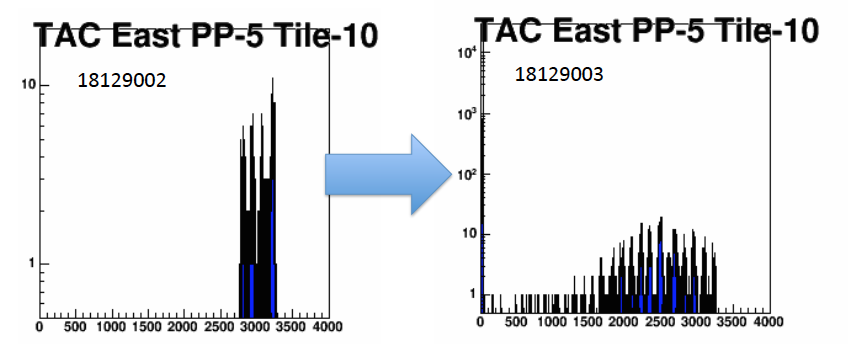
An example of the weird kink can be seen at:

After the modification to the QT8 board, the same "channel" can be seen at:
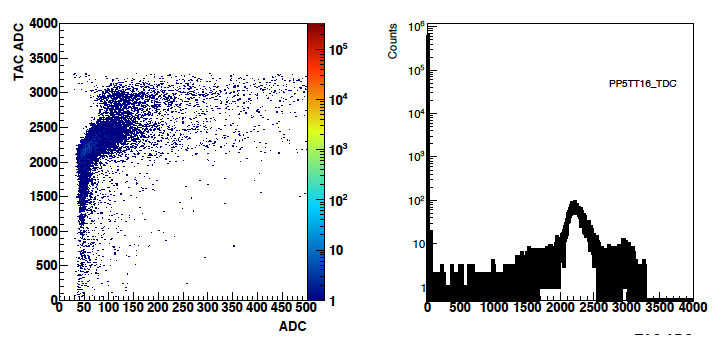
This kink is not seen in any of the QT32B channels, but it is seen in at least 2 QT32C channels. (Maybe more, but earlier runs had the TAC issue which made it hard to see the full range, and with the modification we only have 12 out of 16 channels available to us.)
An example of the split ADC is:

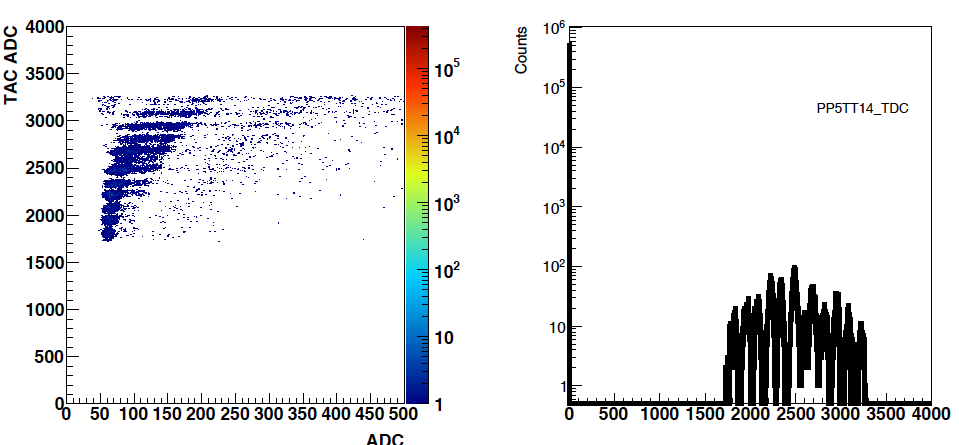
This split is there for most runs with this channel, though it seems to go away on occasion. I have seen no obvious correlation with any settings and it's appearance or disappearance. This structure seems to appear/disappear in a handful of other channels as well.
Analysis
Starting with Run # 18103001 in this analysis, we were attempting to understand some of the weird structures seen in the QT32C with respect to the EPD. At this point, PP5 channels even tiles are the ones that are hooked up to the QT32C.
For this run, the ADC spectra can be found at:
drupal.star.bnl.gov/STAR/system/files/ADC_18103001_0.pdf
And the TAC ADC spectra can be found at:
drupal.star.bnl.gov/STAR/system/files/ADC_TAC_18103001_0.pdf
A typical 32B channel would look like:


A typical 32C channel would look like:

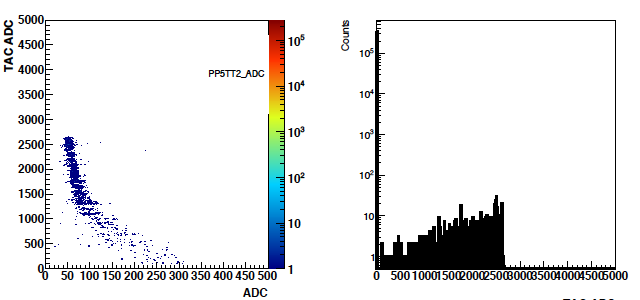
There are several issues with the QT32C structure which were addressed over time. One is that that you get this strange structure with low ADC signals having a high TAC ADC value when the QT32C aren't properly timed in. The "spike" structure is also something that was seen and verified later on. It was established that this was the result of the QT32C settings being left on:
Gate Start QT 32 c - 99(-8)
Gate End QT 32 c - 115(8)
TAC Stop - 56
Instead of:
Nominal values for the gates and thresholds are set.
i.e
For QTC board:
EPD_QTc_Gate_Start_Delay = -20 (87)
EPD_QTc_Gate_End_Delay = -4(103)
TAC Stop = 22
EPD_QTc_Discriminator_Threshold = 64
i.e
EPD_QT_Gate_Start_Delay = -8(99)
EPD_QT_Gate_End_Delay = +8(115)
TAC Stop = 32
EPD_QT_Discriminator_Threshold = 16
This was noted in my presentation: drupal.star.bnl.gov/STAR/system/files/RReed_EPD_04_24_2017.pdf
One issue is that a value entered into a label overwrites the tier1 file.
The proper timing for the QT32C card was put in for run 18115027 (2017 Apr 25 Tue) and beyond.
Once this was done, the TAC and ADC structure for the QT32C look like:
ADC: drupal.star.bnl.gov/STAR/system/files/ADC_18115027.pdf
TAC: drupal.star.bnl.gov/STAR/system/files/ADC_TAC_18115027.pdf
Even though we were "timed in" there were many different issues still present in the data - the spikes and the "weird" structure in the overall TAC distribution, several kinks....
After this, PP5 Tile 14 started to exhibit this weird double peak structure, as shown in:
drupal.star.bnl.gov/STAR/system/files/RReedEPD_DoublePeak_05122017.pdf
Summarized in:

The changes that had been made that day were to the timing (noted above) to the vbias, and to the thresholds as the shift crew did try a threshold scan that had not been entirely successful.
The next day, we were still seeing this same distribution. We can see this at:
ADC: drupal.star.bnl.gov/STAR/system/files/ADC_18116002.pdf
TAC : drupal.star.bnl.gov/STAR/system/files/ADC_TAC_18116002.pdf
The odd channel can be seen at:


It should be noted here that we were still worried about the spikes, the shortened TAC distributions and we did not note this change in the ADC spectrum.
Somehow, this structure seems to come and go. See;

One thing that happened in the middle of these runs was an attempt at a threshold scan.
Then some of the other channels started to pick it up:
.png)
The structure seems to persist through most runs ... it occasionally goes away, but seldomly...
Then we started to look at why some of the TAC structures seemed to be cut off.
drupal.star.bnl.gov/STAR/system/files/RReedEPDQT32Cvs32b05022017.pdf
The cut off followed the QT32C (shown in the presentation)
A characteristic plot can be seen at:

From this run, the total distributions are:
ADC: drupal.star.bnl.gov/STAR/system/files/ADC_18119029.pdf
TAC: drupal.star.bnl.gov/STAR/system/files/ADC_TAC_18119029.pdf
Another thing that can be seen in these slides is the weird kink:

The spikes were removed by a modification to the QT8 boards, see hank's summary at:
drupal.star.bnl.gov/STAR/system/files/QTC_tacs_170504.pdf
Then, it was realized that an issue with the LUT caused the cut-offs in the TAC distribution. From Prashanth:
In Run 18129033, I have set the registers (0x16Zc400c) to route input
data directly to
memory, without LUT. *For all the channels*
Here are the plots:
Please note in these plots, I have increases the events statistics by
factor of 4, compared to previous monitoring plots.
TAC distributions:
https://online.star.bnl.gov/epd/Signal/18129/18129033.TAC.East.4.png
ADC distributions:
https://online.star.bnl.gov/epd/Signal/18129/18129033.ADC.East.4.png
Then the modified QT8 boards were installed to remove the spikes, the results can be seen at:
ADC: drupal.star.bnl.gov/STAR/system/files/ADC_18131097.pdf
TAC: drupal.star.bnl.gov/STAR/system/files/ADC_TAC_18131097.pdf
(mod QT8 boards don't have all the channels the original just for testing purposes)
The spikes are gone, but we still see a weird kink and we still see some splitting:

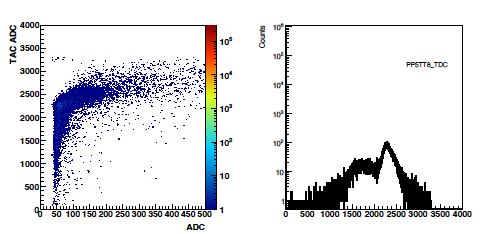
The structure looks a bit weird...
- rjreed's blog
- Login or register to post comments
